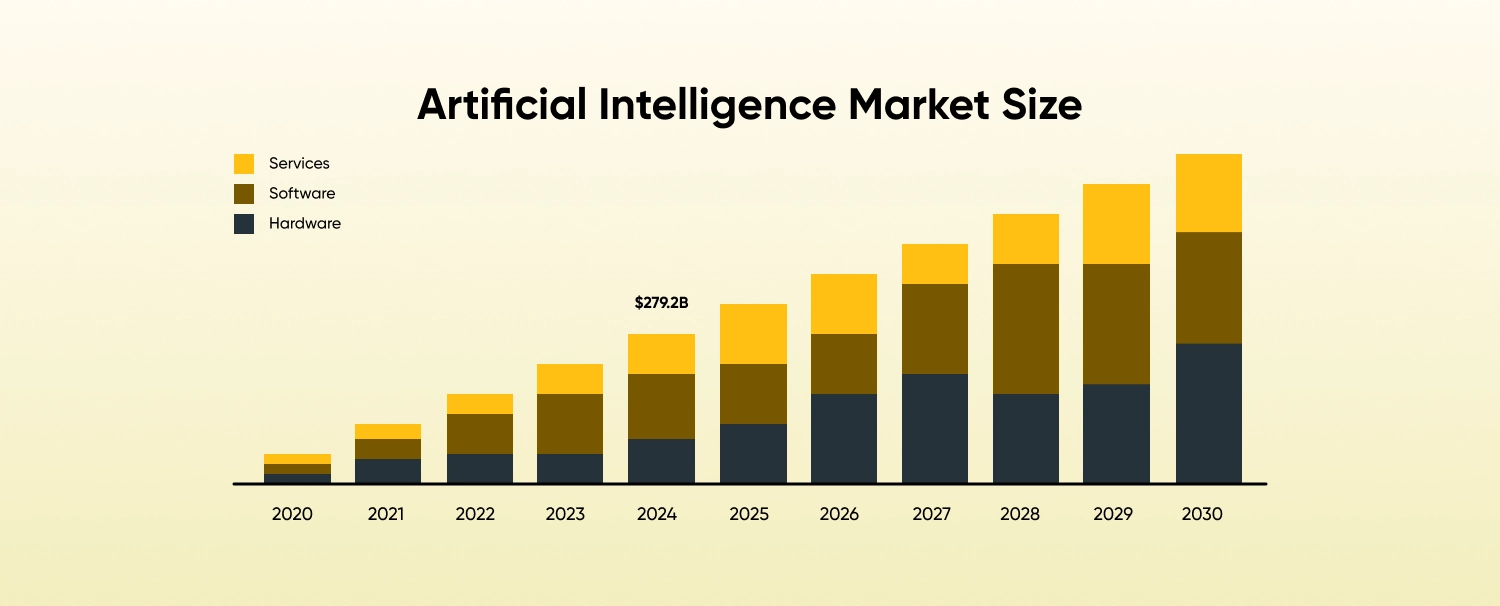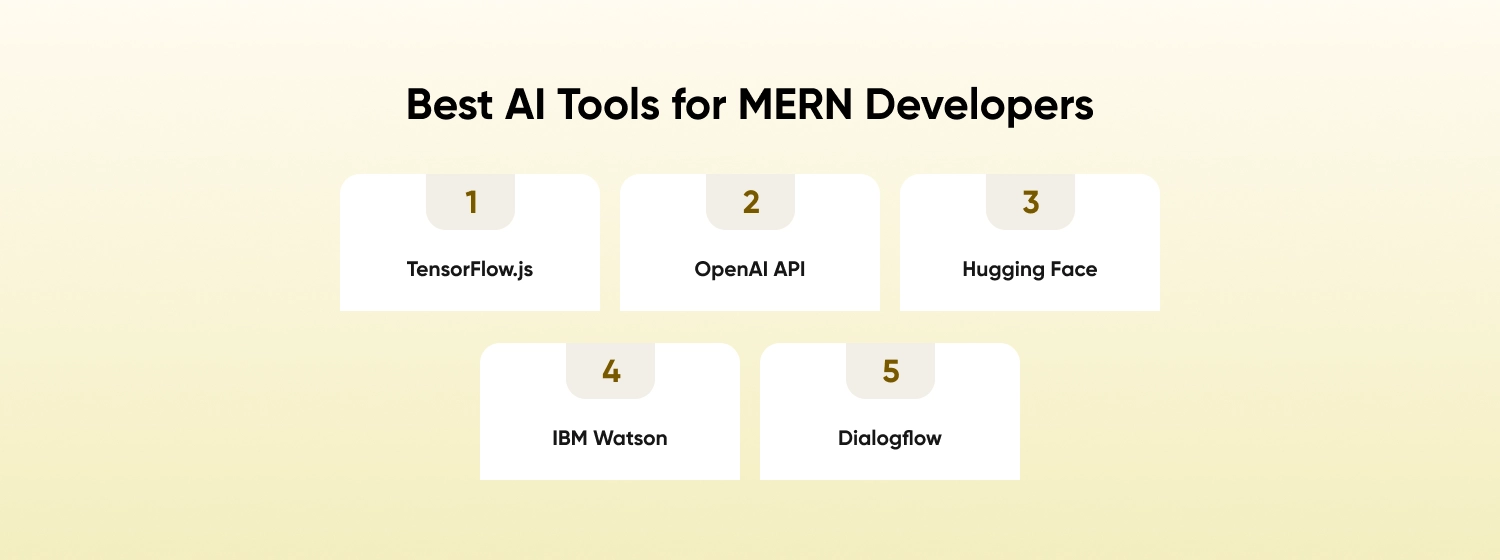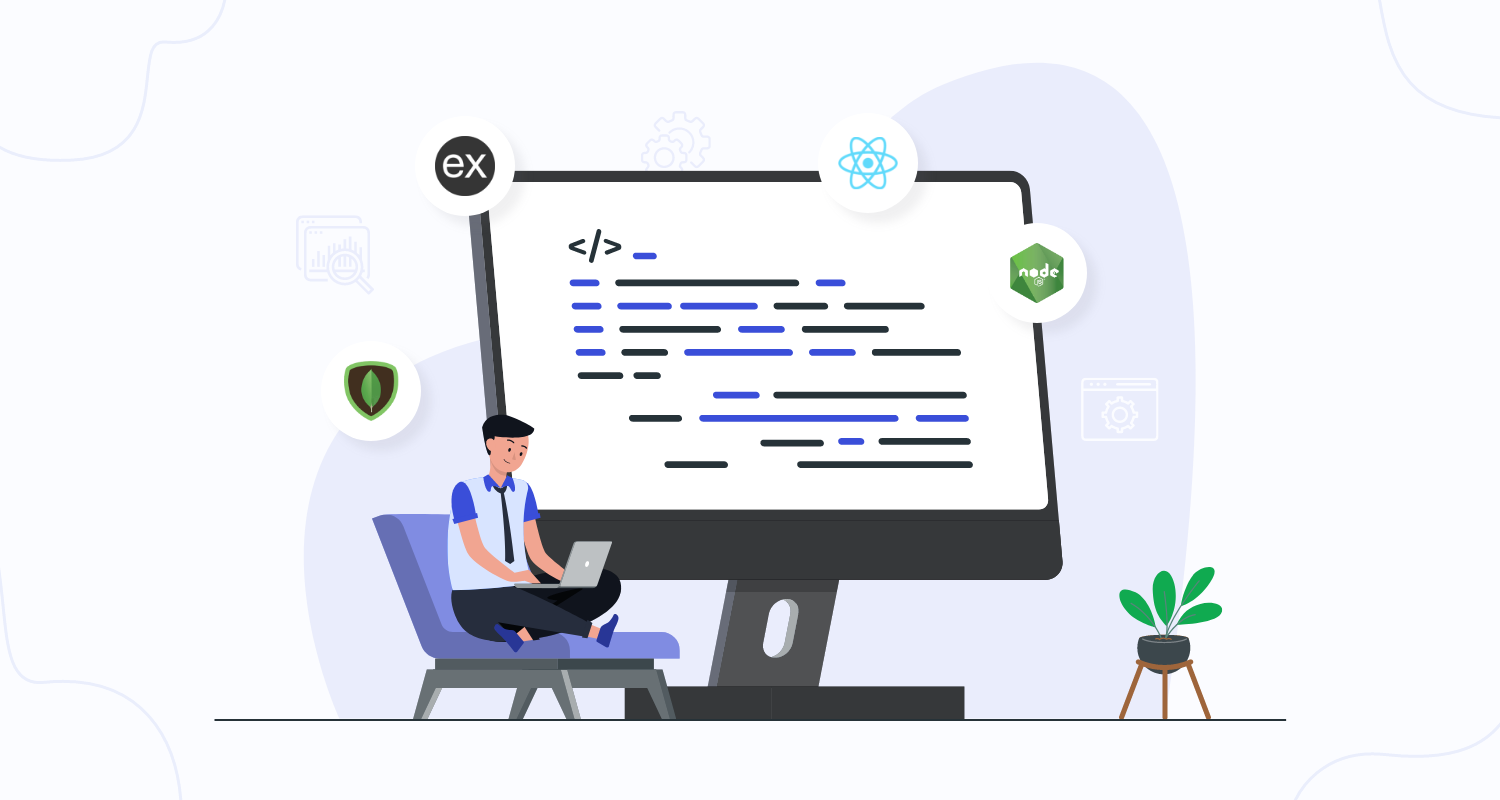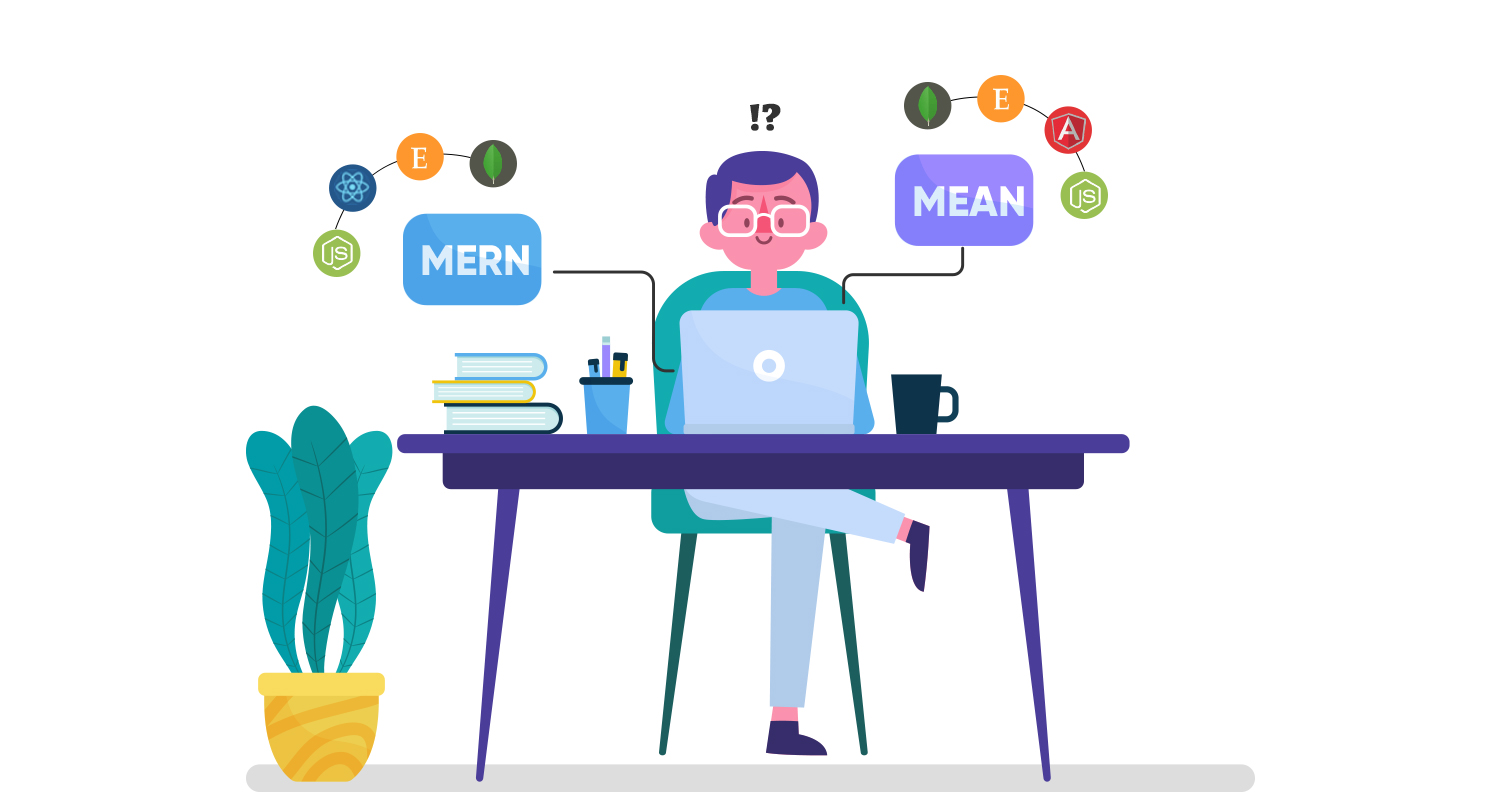MERN Stack is the preferred technology stack and the reason is simple – it works! And combining MERN stack with AI capabilities, is redefining the possibilities of innovation-driven smart app development. Modern web apps can be enhanced with user behaviour analysis, natural language processing, image recognition, and other advanced AI features that deliver personalized experiences to many customers.
By combining AI and MERN stack, developers are able to create sophisticated systems that can be used by small-scale, mid-scale, and enterprise-grade organizations. In this blog we will cover why to create a MERN App Using AI, explore the best AI tools for MERN developers and much more.
You don’t need high-level programming knowledge to integrate AI into web applications. All you need to do is hire MERN stack developers who have knowledge of the right tools for integrating powerful machine learning capabilities in your web applications. This blog will cover all important components, integration strategies, and best practices to integrate AI features in MERN web apps.
The Role of MERN Stack and Popularity of Artificial Intelligence
MERN stack provides a strong base for developing dynamic web applications. Combining MERN stack and AI creates a robust ecosystem for developing smart, data-driven applications. You can use MERN stack and AI for developing chatbots, recommendation systems, predictive analytics, and more.

A study by Grand View Research stated that the AI market size was worth $279.22 billion in 2024. And the size of the AI market is only going to grow at a staggering rate of 35.9% from 2025 to 20230.
What is MERN Stack and Why is it Ideal for AI Integration?
MongoDB
MongoDB is the foundation of the MERN stack. It provides a flexible document-based NoSQL database. It supports data storage in JSON format that is used for handling unstructured data, which is mostly used in AI applications.
Express.js
Express.js is a great middleware framework used for backend operations of MERN applications. It simplifies development of robust APIs and server-side components needed for AI integration.
React.js
React.js is one of the most popular JavaScript frameworks responsible for frontend development in MERN stack based web applications. React uses its virtual DOM to make responsive interfaces capable of displaying AI-generated content.
Node.js
Node.js is the final piece of the MERN stack. It has an event-driven model that makes it efficient at handling concurrent requests, thus providing real-time data streaming ability, which is a common need in AI applications.
Why Use MERN Stack with AI?
Combining MERN stack and AI creates a robust ecosystem for developing smart, data-driven applications. The flow between MERN Stack and AI is ideal for developing chatbots, recommendation systems, predictive analytics, and more. Here is how each component of MERN stack is useful for AI integration:
Flexibility for Full-Stack AI Integration
The MERN stack is based entirely on JavaScript. A unified technology stack results in smooth data flow between application layers. MongoDB JSON structure is ideal for using JavaScript objects in Node.js and React.js, which creates a natural flow when integrating AI features in MERN stack apps.
Unified Language Across the Stack
Since the application is entirely based on JavaScript, developers who are proficient in MERN stack development can easily work across all layers without needing to switch contexts. JavaScript has an active collection of AI libraries that further strengthens its capabilities and makes it capable of AI integration. TensorFlow has a dedicated Tensorflow.js library that brings machine learning capabilities to Node.js based environments.
Modular and Scalable Architecture
Build AI-Powered web app with MERN Stack using React. React.js uses a component-based architecture, and Express.js acts as a middleware. Hence, when you hire MERN stack developers, they are able to easily modularize AI features for efficient scaling and maintenance. Whether you want to integrate real-time recommendations or dynamic content personalization, MERN apps are able to adapt and grow without structural rewrites.
Efficient API Communication for AI Services
Node.js and Express.js are both well-suited for building RESTful APIs or connecting with third party AI integrations. With an efficient group of developers, MERN stack can simplify request handling, data transformation needs, and authentication for efficient AI communication.

The Rise of AI in Web Development
Current Trends in AI
Artificial Intelligence is transforming web development with conversational interfaces using natural language processing. Predictive UX design uses machine learning to understand user needs and customize interfaces accordingly. Similarly, computer vision integration enables applications to analyze visual content, and edge AI moves processing closer to users by running models directly in browsers.
Real-World AI in MERN Stack Applications Use Cases
AI integration in MERN stack applications is changing how businesses engage with users across different industries. From delivering personalized experiences to automating complex decision-making, AI improves the functionality of modern web applications. Here’s how different sectors are leveraging AI within MERN-based systems:
E-commerce: Intelligent Product Recommendations
E-commerce platforms use AI-powered recommendation engines to analyze users’ browsing history, purchase behavior, and preferences. By processing large sets of user interaction data stored in MongoDB and processed through Node.js APIs, MERN-based apps can serve real-time product suggestions that increase conversions and average order value.
Healthcare: Symptom Checkers and Diagnostics
Healthcare applications are integrating AI models—often rule-based or decision tree algorithms—to power interactive symptom checkers. These tools collect user input via React-based forms and deliver assessments through Express APIs, guiding patients toward appropriate care paths while reducing strain on healthcare providers.
Finance: Fraud Detection and Smart Advisory
The fintech industry uses AI for various use cases like real-time fraud detection. It monitors transaction patterns, flags abnormal activities, and reduces false positives. MERN stack applications also deliver AI-driven investment recommendations by connecting to ML models via Node.js, enhancing the user experience with personalized insights.
Education: Adaptive Learning Platforms
EdTech platforms use AI to adjust learning content based on individual student performance. MERN-based applications track progress using MongoDB, and AI algorithms dynamically update content difficulty. This personalized approach improves engagement and knowledge retention across diverse learning groups.
Media: Content Personalization and Engagement
Media and entertainment companies leverage AI to build AI-powered web apps with MERN stack. They develop content recommendation engines that increase viewer retention. Using user interaction data collected in real time, MERN stack applications surface personalized articles, videos, or playlists through React interfaces—boosting both engagement and platform loyalty.
Key Benefits of AI-Powered Web Apps
Personalization at Scale
AI enables applications to deliver truly personalized experiences by processing user data to identify patterns and preferences. E-commerce platforms analyze browsing patterns to suggest products, while news sites curate personalized content feeds. Search functionality becomes tailored to individual users, and interfaces can adapt based on behavior patterns.
Predictive Analytics
Machine learning models identify patterns in historical data to forecast outcomes and enable proactive features. Businesses can predict user churn before it happens, forecast inventory needs based on seasonal patterns, and estimate customer lifetime value to optimize marketing efforts.
Automation and Efficiency
AI-powered features streamline operations by automating repetitive tasks. For instance AI-powered customer chatbots can take care of common inquiries without human intervention. Form completion becomes faster with predictive text suggestions. Content moderation systems automatically filter inappropriate material, while data entry becomes simplified through optical character recognition.
Best AI Tools for MERN Developers in 2025

We saw how efficient MERN stack is for accommodating AI features and capabilities. To truly get the benefits of hiring MERN stack developers, make sure your dedicated developers know how to use these AI tools for smoother AI integration with MERN stack:
TensorFlow.js
TensorFlow.js is an advanced JavaScript-based machine learning library. It allows developers to use ML capabilities directly to the client’s browser as well as server-side with Node.js and mobile with React Native. This tool is ideal for the MERN stack for front-end development with AI capabilities.
OpenAI API
The OpenAI API gives web apps access to advanced language models like GPT with generative AI capabilities like chatbots, text-summarization, content generation, and sentiment analysis.
Hugging Face
Hugging Face is another popular AI tool for MERN developers that want an extensive library of pre-trained models for various tasks like question answering, translation, and even sentiment analysis. It has a dedicated ‘Transformers’ library that can be integrated with Node.js, allowing developers to add high-level NLP features in MERN stack applications, without having to build them from scratch.
IBM Watson
Another promising tool for AI in web development is IBM Watson. This is an enterprise-grade AI platform that comes with a diverse range of AI tools and APIs. It includes support for language translation, speech-to-text, and visual recognition.
It scales easily to match the dynamic needs of enterprise-grade MERN stack applications that need AI-driven data analytics, customer support, and cognitive search functionality.
Dialogflow
We can’t complete the list of best AI tools for MERN developers without a popular Google Cloud-based tool – Dialogflow. It is mainly used to build smart chatbots and voice assistants.
With support for multiple languages, omnichannel deployment, and easy integration with React-based UIs, it is the go-to AI tool for improving customer experience in MERN stack applications.
How to Create a MERN App Using AI?
Here is a detailed breakdown of steps for creating a MERN Stack using AI, or integrating AI into your MERN applications:
Step 1: Set Up the MERN Stack Development Environment
Since the MERN Stack is entirely JavaScript-based, it supports modularity and scalability. Here is a quick rundown of the different purposes each technology solves:
- Node.js and npm form the core for server-side logic and package management.
- MongoDB offers a flexible NoSQL database which supports unstructured and dynamic AI data.
- Express.js is used for routing and middleware management for backend services.
- React.js is used for building modular UIs that can adapt to AI-powered features.
You can set up the environment locally. But if you want to scale or deploy across multiple environments, you should containerize it using Docker.
Step 2: Design the Database for AI-Driven Workflows
Next we need to prepare the database for handling AI-driven processes and workflows. General databases have rigid relational schemas which make it difficult for such integrations, but MongoDB allows developers to set up support for diverse AI data types.
- Store user interaction logs to provide data for behavior tracking or model training.
- Save model input/output data for future analysis or auditability.
- Version AI predictions to support A/B testing or continuous model improvements.
Step 3: Develop the Backend with Express.js
We need to prepare the backend infrastructure. Express.js is a great middleware technology that connects frontend and backend AI services. It handles data transfer, security, and third-party integrations.
- Create connection points where your app can talk to AI tools and models.
- Add helper layers that clean and check data before it goes to the AI brain.
- Build control centers to manage information flows between users and AI systems.
- Set up security gates and secret keys so only the right people can use your AI features.
Step 4: Develop Intelligent User Interfaces with React.js
The frontend is where the show is presented, it is where AI comes alive for users. Hence, it is important that the frontend framework supports AI features and is set up properly for smooth customer experience. Here is how you can setup React for AI integration:
- Provide personalized recommendations with AI.
- Design smart chatbots for improved customer experience.
- Add interactive visualizations to make AI predictions more presentable.
- Improve form validation with features like auto error-detection and auto-completion.
Step 5: Enable Real-Time AI Interactions Using Node.js
Build web apps with MERN and AI to provide real-time capabilities like predictive typing, live recommendations, and other collaborative tools that teams can use for remote work.
- Use Node.js for its non-blocking asynchronous operations, that enables AI inference or API responses.
- Integrate WebSockets for live updates like collaborative AI tools.
- Connect with external AI engines for better communication using cloud or container hosting.
Step 6: Connect External Machine Learning APIs
No AI software development services are complete without machine learning capabilities. Make sure your dedicated development team knows how to set up APIs from established and trusted providers so you can use production-ready AI tools with deep ML expertise.
- Use OpenAI API for generative AI needs like text generation, summarization, and sentiment analysis.
- Add Google Cloud Vision or Amazon Rekognition for image classification and object detection needs.
- Connect speech recognition and synthesis API for conversational interfaces.
Step 7: Build an AI-Ready Backend Pipeline
A successful AI integration relies on the preparation and processing of data. Before serving predictions to the frontend, the backend must handle various pre-inference and post-inference steps.
- Add preprocessing layers to clean, normalize, and format user inputs.
- Queue and batch data for batch inference, useful for intensive models or high traffic.
- Store results efficiently, linking each prediction to relevant context (e.g., user session or time).
- Optimize data transfer through compressed or partial responses to avoid frontend delays.
Step 8: Implement Voice Assistant Capabilities
Take it a step further and add voice assistant capabilities to your AI-driven web applications. It creates a more natural user experience for mobile and accessibility-friendly applications.
- Web Speech API is used for changing spoken language into text format.
- Pass the input through a NLP engine to interpret user intent.
- Use text-to-speech synthesis to generate audible responses from your application.
Step 9: Integrate Image Recognition Features
Visual intelligence adds significant depth to applications, especially in sectors like healthcare, eCommerce, or security.
- Allow users to upload images for analysis using drag-and-drop interfaces and preview functionality.
- Process these images through AI vision APIs for detecting objects, reading text, or analyzing emotions.
- Return results with confidence scores and annotations, displayed clearly within the UI.
Security Considerations for AI Features
Securing your AI-powered application requires special attention. Here are some best practices for securing AI implementation that you should follow:
- Implement rate limiting to protect expensive AI operations from abuse.
- Apply proper authentication and authorization to ensure only authorized users access sensitive AI features.
- Encrypt user data and AI model parameters to maintain privacy.
Performance Optimization Tips for AI-Driven MERN Stack App Development
AI-powered features can add great functionality to your web applications, however if it is not implemented properly, it can also increase the load on both client and server. Hence, it is important to keep in mind to not sacrifice response time and make sure resource usage doesn’t spike. For this you need to optimize AI component integration with MERN stack applications.
Cache AI Responses for Avoiding Repetition
Many AI operations such as text summarization or product recommendation, provide the same output when given the same input. To make this process efficient, you should use proper caching mechanisms to store and reuse these outputs and not reprocess them entirely with every request. This will significantly reduce the load of AI services.
Optimize Model Loading and Execution
Heavy machine learning models can cause delays if not managed properly. Load models only when needed, and consider techniques like lazy loading or model compression. Keeping models lightweight or choosing smaller versions can also help reduce execution time.
Divide the Workload between Client Side and Server Side
Don’t try to do everything on the server, make use of tools like Tensorflow.js for diving and shifting certain tasks to the user’s browser (client-side). This reduces the load on the server, improves performance, and provides real-time feedback without needing to communicate with the backend for everything. Make sure not to shift any sensitive detail to client-side rendering.
Make Use of Asynchronous Processing for Non-Critical Tasks
Not all AI features need to run immediately. For example, background insights or behavioral analysis can be processed asynchronously. Queue these tasks so they don’t interfere with core user actions, ensuring a smoother experience overall.
Monitor and Profile AI Feature Usage
Track how AI components are performing under real-world conditions. Use monitoring tools to identify latency issues, memory spikes, or bottlenecks.
Why Hire AI Developers from CMARIX?
Being a reliable AI software development company, CMARIX has a dedicated team of skilled developers that can build tailored intelligent digital products. Hire AI developers for gaining deep technical knowledge, industry experience, and a product-centric approach for developing AI-enabled solutions.
Domain-Centric AI Expertise
Our AI developers provide cross-industry expertise across retail, logistics, fintech, and 46+ other industries. This ensures all AI integrations are technically accurate and provide context-aware specific business operations.
Full-Cycle AI Development
We cover all steps of the AI lifecycle, including data preprocessing and model training to validation, integration, and optimization. Our sprint-based development phases are aligned to your business goals, compliance needs, and real-time performance requirements.
Scalable and Production-Ready Solutions
We provide AI MVP development services and AI PoC development services for testing your product before committing to a full-fledged application. We only provide enterprise-grade systems whether for cloud-based deployment, edge AI, or real-time analytics.
Seamless Tech Integration
We make sure that the AI components work flawlessly with your existing software stacks. Our developers provide full-stack solutions and services across front-end, backend, and DevOps to integrate machine learning models into apps, dashboards, CRMs, and more, without disrupting workflows.
Final Words
AI-powered MERN stack applications are shaping the future of smart, responsive digital solutions. Combining full-stack flexibility with advanced AI capabilities enables rapid, scalable development across industries. From predictive insights to personalized experiences, the synergy of MERN and AI delivers real business value. Embracing this approach positions businesses to lead in a competitive, innovation-driven landscape.
FAQs on How to Build an AI-Powered Web App with MERN Stack
What is the MERN Stack, and how is it used with AI for web development?
MERN stack is a full-stack solution that can be used with AI by connecting frontend interfaces with AI-powered backend services. There are many different ways AI can be added to the MERN stack for creating smart web apps, e-commerce websites, data analytics, and more.
How to integrate AI with MERN Stack?
AI integration connects the Node.js backend to Python-based AI models with robust APIs. React handles user inputs, Express takes care of API routes, and MongoDB stores data for training or predictions.
Is it possible to integrate machine learning models into a MERN Stack Application?
Yes, with help of skilled AI MERN stack developers, we can integrate ML models by hosting them as APIs with FastAPI or Flask. The MERN app sends data to these endpoints, displays predictions, and makes smart features easily accessible.
What libraries or tools are needed to add AI features to a MERN App?
Tools include TensorFlow.js for browser-based AI, Flask/FastAPI for backend models, and Axios for API calls. Docker is used for deployment, while MongoDB supports storing datasets, AI results, and user interactions efficiently.
Is MERN stack ideal for developing scalable AI-enabled applications?
Yes, MERN’s modular architecture supports scalable AI apps. React handles dynamic UI, Node.js ensures fast server performance, and MongoDB manages data flow—ideal for cloud deployments, real-time predictions, and continuously evolving intelligent features.







